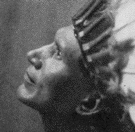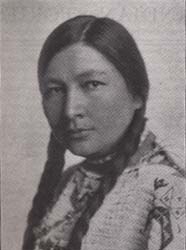The Printed Word:
Native American Responses
to the
Culture of
Incorporation
Despite their status as America's unincorporated, Native Americans used a typically American means of voicing their displeasure, the printed word. Writers like Zitkala Sa, Ah-nen-la-de-ni, and Chief Joseph used publication in popular journals like Harper's and Century to expose the victimization of Native Americans by the systemized incorporation of their peoples. Native Americans used their writing as a means to explain their experience as victims at the hands of the agents and agencies of incorporation, and at institutions such as the Boarding Schools where they
were denied their names, their languages, and any chance to
maintain family ties.
| These Native
American writers also used their publications to rewrite
American history from the perspective of the conquered
Native American. As we will see Native American
contributions to American history such as
Ohiyesa's[Charles Eastman] biographies of famous
"Indian" chiefs and warriors told different stories and
added many different dimensions to a story of Native
America that was for the most part dominated by white
presses who described Native Americans as sub
human. |
 |
 |
A Note On the
Sources
As
their use of English suggests the majority of the
writers included in this anthology grew up in both the
world of the Native American and the culture of
incorporation. Some like Zitkala Sa[Gertrude Bonnin],
whose father was white man that she never knew and whose
mother was a full blooded Sioux, signified the depth to
which these cultures were intermingled at this time. As
victims of cultural imperialism Native Americans of this
era were threatened with the loss of their culture,
their language, and their history. In fact many Native
Americans returned to the reservations doubly
unincorporated as their English education had rid them
of all vestiges of their culture and they returned home
"strangers." |
As the section on
Native Traditions and Religion signifies Native American
writers wrote with the hope of preserving their Native
culture, but more than that these Native Americans used their
self-expression as a means to reveal the humanity of Native
Americans and the inherent value of their way of life.
The purpose of this anthology is to allow Native Americans from this period to speak for themselves and to paint a portrait of the Native American experience in the age of incorporation. Including sections on Indian Childhood, The Boarding School Experience, American History Retold from the Native American Perspective,Names and Naming,Native Religions and Traditionsand On the Reservation this anthology hopes to expose the experience
of the Native American before, during, and after
cross-cultural contact. This site also provides links to more
information on the authors included and when possible a
bibliography. Although Native Americans form the majority of
the writers listed when relevant documents written by white
writers, such as author of the Dawes Severalty Act Senator
Henry Dawes, have also been included for the purposes of
context and comparison. Although their opinions about the
incorporation of their cultures differed as extensively as
their personal and tribal histories, their voices when taken
as a whole paint a brutal picture of their people as victims
of the system of cultural imperialism known as incorporation.
Their voices reveal the forced assimilation of America's first
peoples into the culture of mainstream, middle class, white
America. NEXT: INDIAN CHILDHOOD

|